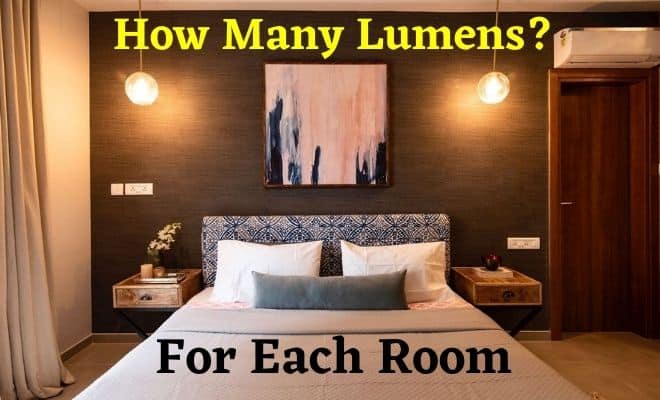Last Updated on August 19, 2022 by The Tutor
How Many Lumens Do I Need?

To determine how many lumens you need, you will need to identify the type of lighting you need and its application. Rooms where you have a more relaxed atmosphere may require 20-40 lumens per square foot while well lit areas such as kitchens, baths and garages may require 60-80 lumens per square foot.
What Are Lumens?
If you want to measure the brightness of a light bulb or any lighting fixture, you need to find out how many lumens the lighting fixture can provide. The term lumens is a unit of luminous flux that is used to measure the total amount of light visible to the human eyes. In general, a light fixture that has a higher lumen rating provides brighter light compared to the one with a lower lumen rating.
Lumens vs Watts
While lumens are a unit that measures the brightness of a lamp, watts measure how much energy a certain light bulb will consume. People used to determine the brightness of an incandescent light bulb by looking at how many watts it uses. However, with the new energy-efficient LED technology, using watts as a unit to measure a light bulb’s brightness is no longer reliable. This is the reason why people nowadays are using lumens to determine how bright a lighting fixture is. We are also starting to see home improvement stores begin to label the bulbs using lumens instead of watts.
This means that lumens are equal to brightness, while watts are equal to energy usage. A light bulb that provides higher lumens at a low power wattage is energy-efficient. Simply put, if you need more light but want to save on energy costs, you have to find a light bulb that provides more lumens at low wattage.
How Many Lumens Are There in a Watt?
The number of lumens in a watt will vary depending on the type of lighting fixture used. It’s important to know how many Watts each type of light bulb uses especially if you want to save on energy costs. Refer to the table below to determine the brightness of a certain type of lighting and how much energy in watts it uses.
Lumens to Watts Table
| Lumens | Incandescent Light | Halogen | CFL | LED |
| 1600 | 100 Watts | up to 72 Watts | up to 26 Watts | up to 22 Watts |
| 1100 | 75 Watts | up to 53 Watts | up to 23 Watts | up to 20 Watts |
| 800 | 60 Watts | up to 43 Watts | up to 15 Watts | up to 12 Watts |
| 450 | 40 Watts | up to 29 Watts | up to 11 Watts | up to 9 Watts |
Based on the table above, the most energy-efficient lighting fixture is a LED light. It can provide the highest level of brightness( lumens) while consuming the least power (watts) — in short, it gives you more light while using less energy. Using incandescent lighting consumes more energy compared to the other types of lighting fixtures mentioned above.
How Many Lumens Do I Need?
There are different factors that you need to consider to find out how many lumens you will need. Aside from the size and shape of the room, you also need to consider the type of lighting fixture you will use, the height of the ceiling, and your personal needs and preferences. In general, the bigger the room space is, the brighter the lighting should be.
Further, the type of room, and the tasks you are supposed to do in that room, are also important factors that you should consider when deciding how many lumens of light to use. For instance, you may need a brighter lighting fixture for your kitchen and living room than your bedroom (because you only usually use the bedroom to rest and sleep) and bathroom (because bathrooms are typically smaller in space).
Lumens Chart
Here is the basic guide in determining how many lumens you will need per square foot for different room settings:
| Room type | Minimum lumens per sq ft |
| Kitchen | 60 to 80 lumens |
| Dining Room | 30 to 40 lumens |
| Living Room | 40 to 50 lumens |
| Bedroom | 30 to 40 lumens |
| Study Room or Home Office | 60 to 80 lumens |
| Hallway | 30 |
| Bathroom | 50 to 80 lumens (depending on personal preference) |
| Garage | 60-80 |
Understanding Color Temperature
To choose the best lighting for your specific room settings, it’s also ideal to consider the color temperature of a lighting fixture. The unit used to measure the color temperature in a light bulb is called Kelvin, which s typically expressed as K. In general, a bulb with a higher Kelvin rating emits a whiter and cooler light compared to the one with a lower Kelvin rating, which emits a yellowish light.
If a light bulb has a high Kelvin rating, it provides a bright light that has a bluish daylight cast. Light fixtures with a lower Kelvin rating provide a warm, yellowish tinge. For household lighting fixtures, the ideal color temperatures range between 2700K to 3500K. Color temperatures that are higher than 3500K are typically used for commercial, hotel, and hospital settings.
While it’s important to check the ideal number of lumens for each room setting, understanding the color temperature can also help guide you in determining which lighting fixture is right for a particular room. A light fixture with a higher color temperature can give a feeling of more light vs a fixture with a lower color temperature.
Here is the basic guide in understanding the Kelvin color temperature settings:
| Kelvin | What it looks like | Best for |
| Less than 2000K | A dim glow of light, like a candlelight | Low-light areas where ambient illumination is preferred |
| 2000K to 3000K | A soft warm white glow that looks yellowish | Small living rooms, dining rooms, bedrooms, and outdoor spaces |
| 3100K to 4500K | A bright white light | Kitchens, offices, workspaces, vanities, and other areas where task lighting is needed |
| 4600K to 6500K | A bright, blue-white light, like a daylight | Commercial spaces, display areas, and work environments where very bright illumination is needed |
| 6500K and higher | A very bright, bluish hue of light, like the sky on a sunny day | Commercial places and other areas that need bright task lighting |
For more information on the Kelvin color temperature decision, Read: [Kelvin Color Temperature Explained]
Finding the Right Lighting Fixture
In order to find the right lighting fixture, it’s important to know what works best for a particular room setting. In general, there are three things that you need to consider:
First, the light bulb’s brightness, which is presented in lumens.
Second, the amount of energy it uses, which is measured in terms of Watts,
Third, the color temperature, which is measured in Kelvin. These are three important factors that you should know before deciding which light bulb to use for a specific area.
You will need to put some thought into pairing the light fixture with a bulb that offers the perfect amount of lumens for the room and also for the fixture.
Helpful Lighting Articles
Planning Your Bathroom Lighting
